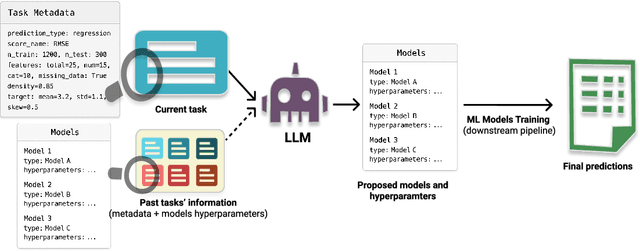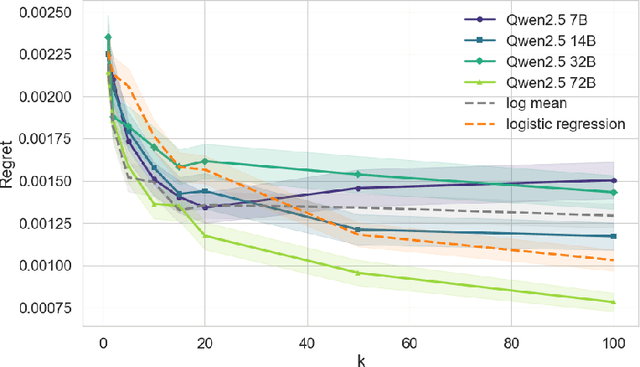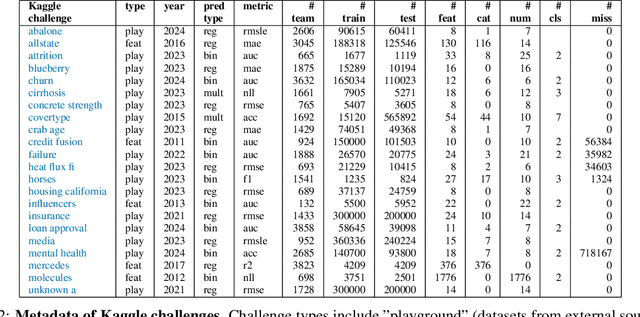Recommendation
Recommendation is the task of providing personalized suggestions to users based on their preferences and behavior.
Papers and Code
Pairwise and Attribute-Aware Decision Tree-Based Preference Elicitation for Cold-Start Recommendation
Oct 31, 2025Recommender systems (RSs) are intelligent filtering methods that suggest items to users based on their inferred preferences, derived from their interaction history on the platform. Collaborative filtering-based RSs rely on users past interactions to generate recommendations. However, when a user is new to the platform, referred to as a cold-start user, there is no historical data available, making it difficult to provide personalized recommendations. To address this, rating elicitation techniques can be used to gather initial ratings or preferences on selected items, helping to build an early understanding of the user's tastes. Rating elicitation approaches are generally categorized into two types: non-personalized and personalized. Decision tree-based rating elicitation is a personalized method that queries users about their preferences at each node of the tree until sufficient information is gathered. In this paper, we propose an extension to the decision tree approach for rating elicitation in the context of music recommendation. Our method: (i) elicits not only item ratings but also preferences on attributes such as genres to better cluster users, and (ii) uses item pairs instead of single items at each node to more effectively learn user preferences. Experimental results demonstrate that both proposed enhancements lead to improved performance, particularly with a reduced number of queries.
Traceable Drug Recommendation over Medical Knowledge Graphs
Oct 31, 2025



Drug recommendation (DR) systems aim to support healthcare professionals in selecting appropriate medications based on patients' medical conditions. State-of-the-art approaches utilize deep learning techniques for improving DR, but fall short in providing any insights on the derivation process of recommendations -- a critical limitation in such high-stake applications. We propose TraceDR, a novel DR system operating over a medical knowledge graph (MKG), which ensures access to large-scale and high-quality information. TraceDR simultaneously predicts drug recommendations and related evidence within a multi-task learning framework, enabling traceability of medication recommendations. For covering a more diverse set of diseases and drugs than existing works, we devise a framework for automatically constructing patient health records and release DrugRec, a new large-scale testbed for DR.
Inferring trust in recommendation systems from brain, behavioural, and physiological data
Oct 31, 2025As people nowadays increasingly rely on artificial intelligence (AI) to curate information and make decisions, assigning the appropriate amount of trust in automated intelligent systems has become ever more important. However, current measurements of trust in automation still largely rely on self-reports that are subjective and disruptive to the user. Here, we take music recommendation as a model to investigate the neural and cognitive processes underlying trust in automation. We observed that system accuracy was directly related to users' trust and modulated the influence of recommendation cues on music preference. Modelling users' reward encoding process with a reinforcement learning model further revealed that system accuracy, expected reward, and prediction error were related to oscillatory neural activity recorded via EEG and changes in pupil diameter. Our results provide a neurally grounded account of calibrating trust in automation and highlight the promises of a multimodal approach towards developing trustable AI systems.
Offline Clustering of Preference Learning with Active-data Augmentation
Oct 30, 2025Preference learning from pairwise feedback is a widely adopted framework in applications such as reinforcement learning with human feedback and recommendations. In many practical settings, however, user interactions are limited or costly, making offline preference learning necessary. Moreover, real-world preference learning often involves users with different preferences. For example, annotators from different backgrounds may rank the same responses differently. This setting presents two central challenges: (1) identifying similarity across users to effectively aggregate data, especially under scenarios where offline data is imbalanced across dimensions, and (2) handling the imbalanced offline data where some preference dimensions are underrepresented. To address these challenges, we study the Offline Clustering of Preference Learning problem, where the learner has access to fixed datasets from multiple users with potentially different preferences and aims to maximize utility for a test user. To tackle the first challenge, we first propose Off-C$^2$PL for the pure offline setting, where the learner relies solely on offline data. Our theoretical analysis provides a suboptimality bound that explicitly captures the tradeoff between sample noise and bias. To address the second challenge of inbalanced data, we extend our framework to the setting with active-data augmentation where the learner is allowed to select a limited number of additional active-data for the test user based on the cluster structure learned by Off-C$^2$PL. In this setting, our second algorithm, A$^2$-Off-C$^2$PL, actively selects samples that target the least-informative dimensions of the test user's preference. We prove that these actively collected samples contribute more effectively than offline ones. Finally, we validate our theoretical results through simulations on synthetic and real-world datasets.
WeaveRec: An LLM-Based Cross-Domain Sequential Recommendation Framework with Model Merging
Oct 30, 2025Cross-Domain Sequential Recommendation (CDSR) seeks to improve user preference modeling by transferring knowledge from multiple domains. Despite the progress made in CDSR, most existing methods rely on overlapping users or items to establish cross-domain correlations-a requirement that rarely holds in real-world settings. The advent of large language models (LLM) and model-merging techniques appears to overcome this limitation by unifying multi-domain data without explicit overlaps. Yet, our empirical study shows that naively training an LLM on combined domains-or simply merging several domain-specific LLMs-often degrades performance relative to a model trained solely on the target domain. To address these challenges, we first experimentally investigate the cause of suboptimal performance in LLM-based cross-domain recommendation and model merging. Building on these insights, we introduce WeaveRec, which cross-trains multiple LoRA modules with source and target domain data in a weaving fashion, and fuses them via model merging. WeaveRec can be extended to multi-source domain scenarios and notably does not introduce additional inference-time cost in terms of latency or memory. Furthermore, we provide a theoretical guarantee that WeaveRec can reduce the upper bound of the expected error in the target domain. Extensive experiments on single-source, multi-source, and cross-platform cross-domain recommendation scenarios validate that WeaveRec effectively mitigates performance degradation and consistently outperforms baseline approaches in real-world recommendation tasks.
LLMs as In-Context Meta-Learners for Model and Hyperparameter Selection
Oct 30, 2025



Model and hyperparameter selection are critical but challenging in machine learning, typically requiring expert intuition or expensive automated search. We investigate whether large language models (LLMs) can act as in-context meta-learners for this task. By converting each dataset into interpretable metadata, we prompt an LLM to recommend both model families and hyperparameters. We study two prompting strategies: (1) a zero-shot mode relying solely on pretrained knowledge, and (2) a meta-informed mode augmented with examples of models and their performance on past tasks. Across synthetic and real-world benchmarks, we show that LLMs can exploit dataset metadata to recommend competitive models and hyperparameters without search, and that improvements from meta-informed prompting demonstrate their capacity for in-context meta-learning. These results highlight a promising new role for LLMs as lightweight, general-purpose assistants for model selection and hyperparameter optimization.
Using Salient Object Detection to Identify Manipulative Cookie Banners that Circumvent GDPR
Oct 30, 2025The main goal of this paper is to study how often cookie banners that comply with the General Data Protection Regulation (GDPR) contain aesthetic manipulation, a design tactic to draw users' attention to the button that permits personal data sharing. As a byproduct of this goal, we also evaluate how frequently the banners comply with GDPR and the recommendations of national data protection authorities regarding banner designs. We visited 2,579 websites and identified the type of cookie banner implemented. Although 45% of the relevant websites have fully compliant banners, we found aesthetic manipulation on 38% of the compliant banners. Unlike prior studies of aesthetic manipulation, we use a computer vision model for salient object detection to measure how salient (i.e., attention-drawing) each banner element is. This enables the discovery of new types of aesthetic manipulation (e.g., button placement), and leads us to conclude that aesthetic manipulation is more common than previously reported (38% vs 27% of banners). To study the effects of user and/or website location on cookie banner design, we include websites within the European Union (EU), where privacy regulation enforcement is more stringent, and websites outside the EU. We visited websites from IP addresses in the EU and from IP addresses in the United States (US). We find that 13.9% of EU websites change their banner design when the user is from the US, and EU websites are roughly 48.3% more likely to use aesthetic manipulation than non-EU websites, highlighting their innovative responses to privacy regulation.
Bridging the Gap between Empirical Welfare Maximization and Conditional Average Treatment Effect Estimation in Policy Learning
Oct 30, 2025The goal of policy learning is to train a policy function that recommends a treatment given covariates to maximize population welfare. There are two major approaches in policy learning: the empirical welfare maximization (EWM) approach and the plug-in approach. The EWM approach is analogous to a classification problem, where one first builds an estimator of the population welfare, which is a functional of policy functions, and then trains a policy by maximizing the estimated welfare. In contrast, the plug-in approach is based on regression, where one first estimates the conditional average treatment effect (CATE) and then recommends the treatment with the highest estimated outcome. This study bridges the gap between the two approaches by showing that both are based on essentially the same optimization problem. In particular, we prove an exact equivalence between EWM and least squares over a reparameterization of the policy class. As a consequence, the two approaches are interchangeable in several respects and share the same theoretical guarantees under common conditions. Leveraging this equivalence, we propose a novel regularization method for policy learning. Our findings yield a convex and computationally efficient training procedure that avoids the NP-hard combinatorial step typically required in EWM.
Barlow Twins for Sequential Recommendation
Oct 30, 2025Sequential recommendation models must navigate sparse interaction data popularity bias and conflicting objectives like accuracy versus diversity While recent contrastive selfsupervised learning SSL methods offer improved accuracy they come with tradeoffs large batch requirements reliance on handcrafted augmentations and negative sampling that can reinforce popularity bias In this paper we introduce BT-SR a novel noncontrastive SSL framework that integrates the Barlow Twins redundancyreduction principle into a Transformerbased nextitem recommender BTSR learns embeddings that align users with similar shortterm behaviors while preserving longterm distinctionswithout requiring negative sampling or artificial perturbations This structuresensitive alignment allows BT-SR to more effectively recognize emerging user intent and mitigate the influence of noisy historical context Our experiments on five public benchmarks demonstrate that BTSR consistently improves nextitem prediction accuracy and significantly enhances longtail item coverage and recommendation calibration Crucially we show that a single hyperparameter can control the accuracydiversity tradeoff enabling practitioners to adapt recommendations to specific application needs
OneTrans: Unified Feature Interaction and Sequence Modeling with One Transformer in Industrial Recommender
Oct 30, 2025In recommendation systems, scaling up feature-interaction modules (e.g., Wukong, RankMixer) or user-behavior sequence modules (e.g., LONGER) has achieved notable success. However, these efforts typically proceed on separate tracks, which not only hinders bidirectional information exchange but also prevents unified optimization and scaling. In this paper, we propose OneTrans, a unified Transformer backbone that simultaneously performs user-behavior sequence modeling and feature interaction. OneTrans employs a unified tokenizer to convert both sequential and non-sequential attributes into a single token sequence. The stacked OneTrans blocks share parameters across similar sequential tokens while assigning token-specific parameters to non-sequential tokens. Through causal attention and cross-request KV caching, OneTrans enables precomputation and caching of intermediate representations, significantly reducing computational costs during both training and inference. Experimental results on industrial-scale datasets demonstrate that OneTrans scales efficiently with increasing parameters, consistently outperforms strong baselines, and yields a 5.68% lift in per-user GMV in online A/B tests.
 Add to Chrome
Add to Chrome Add to Firefox
Add to Firefox Add to Edge
Add to Edge